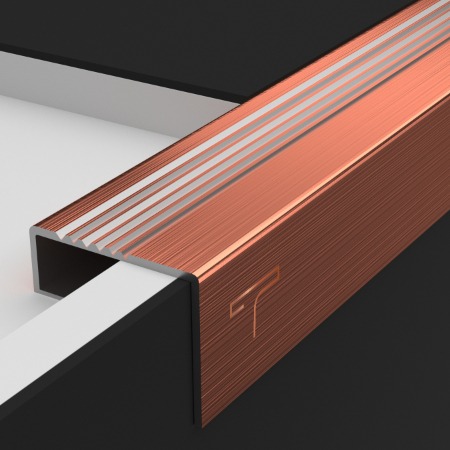Staircases are a vital part of many buildings, but they can also be a safety hazard if not properly equipped. That’s where Stair Nosing Profiles come into play. These essential components not only enhance the safety of stairs but also add an aesthetic touch. When it comes to materials, stainless steel stands out for its durability, sleek appearance, and minimal maintenance requirements.
Types of Stair Nosing Profiles
L-Shaped Profiles
L-shaped profiles are the most common type of stair nosing. They provide a right-angle finish to the edge of each step, offering a clean and sharp look while improving grip.
T-Shaped Profiles
T-shaped profiles are used to bridge two different flooring materials at the edge of stairs. They are perfect for creating a seamless transition between steps and adjacent floors.
Bullnose Profiles
Bullnose profiles feature a rounded edge, which not only enhances safety by reducing sharp edges but also gives a softer look to the staircase.
Custom Profiles
Custom profiles can be designed to meet specific architectural requirements. They offer flexibility in terms of shape, size, and finish, making them ideal for unique or bespoke projects.
Benefits of Using Stainless Steel Stair Nosing
Durability and Strength
Stainless steel is known for its robustness. It can withstand heavy traffic and harsh conditions, making it a long-lasting choice for stair nosing.
Aesthetic Appeal
With its sleek, modern look, stainless steel adds a touch of elegance to any staircase. It complements a variety of interior styles, from contemporary to industrial.
Safety Enhancement
Stainless steel stair nosing improves safety by providing a non-slip surface and highlighting the edge of each step, reducing the risk of trips and falls.
Easy Maintenance
Maintaining stainless steel is straightforward. It resists stains, corrosion, and wear, requiring only minimal cleaning to keep it looking new.
Applications of Stainless Steel Stair Nosing
Residential Buildings
In homes, stainless steel stair nosing not only enhances safety but also adds a stylish element to staircases.
Commercial Spaces
Commercial environments benefit from the durability and professional look of stainless steel stair nosing, making it suitable for offices, shops, and restaurants.
Industrial Settings
In industrial settings, the robustness of stainless steel is crucial. It withstands heavy machinery and foot traffic, ensuring longevity.
Public Areas
Public spaces such as airports, hospitals, and schools require materials that are both durable and easy to maintain. Stainless steel fits the bill perfectly.
Installation Process
Preparing the Stairs
Before installation, ensure the stairs are clean, dry, and free of debris. This creates a solid foundation for the nosing.
Measuring and Cutting the Nosing
Accurate measurements are crucial. Measure each step and cut the nosing to fit perfectly.
Securing the Nosing to the Stairs
Use appropriate adhesives and screws to secure the nosing to the stairs. Make sure it’s firmly attached to prevent any movement.
Finishing Touches
After installation, check for any sharp edges or uneven sections. Smooth these out to ensure a flawless finish.
Maintenance Tips for Stainless Steel Stair Nosing
Regular Cleaning
Regular cleaning with a damp cloth and mild detergent helps maintain the shine and prevents dirt buildup.
Avoiding Harsh Chemicals
Avoid using harsh chemicals or abrasive materials, as they can damage the surface of the stainless steel.
Polishing Tips
Occasionally, polish the nosing with a stainless steel cleaner to maintain its luster and remove any minor scratches.
Comparing Stainless Steel with Other Materials
Aluminum
Aluminum is lightweight and corrosion-resistant but not as durable as stainless steel.
Brass
Brass offers a unique look but requires more maintenance to prevent tarnishing.
Wood
Wood provides a natural aesthetic but lacks the durability and low maintenance of stainless steel.
Vinyl
Vinyl is cost-effective and easy to install but doesn’t offer the same level of durability or elegance.
Cost Considerations
Initial Investment
Stainless steel may have a higher upfront cost compared to other materials, but it pays off in the long run.
Long-term Savings
Its durability means fewer replacements and repairs, leading to long-term savings.
Cost vs. Value Analysis
When considering cost vs. value, stainless steel provides excellent value due to its longevity and minimal maintenance needs.
Environmental Impact
Sustainability of Stainless Steel
Stainless steel is highly sustainable. It’s 100% recyclable, which reduces its environmental footprint.
Recycling Benefits
Recycling stainless steel requires less energy compared to producing new material, contributing to environmental conservation.
Choosing the Right Stair Nosing Profile
Factors to Consider
Consider factors such as stair traffic, environmental conditions, and aesthetic preferences when choosing a profile.
Matching with Interior Design
Select a profile that complements the overall interior design of your space.
Customization Options
Explore customization options to meet specific design and functional requirements.
Common Mistakes to Avoid
Incorrect Measurements
Always double-check measurements to ensure the nosing fits perfectly.
Improper Installation Techniques
Follow the manufacturer’s installation guidelines to avoid issues.
Overlooking Maintenance
Regular maintenance is key to preserving the look and functionality of stainless steel stair nosing.
Trends in Stair Nosing Design
Modern Aesthetic Trends
Current trends favor sleek, minimalistic designs that enhance the modern look of spaces.
Functional Innovations
Innovations include integrated lighting and enhanced non-slip features for added safety.
Case Studies
Successful Residential Projects
Highlighting successful installations in homes where stainless steel stair nosing improved both safety and aesthetics.
Commercial Installations
Examples of commercial spaces that have benefitted from the durability and professional look of stainless steel stair nosing.
Expert Tips and Recommendations
Advice from Professionals
Professional tips on selecting, installing, and maintaining stainless steel stair nosing.
User Experiences
Feedback and experiences from users who have installed stainless steel stair nosing in their spaces.
Conclusion
Stainless steel stair nosing profiles are an excellent choice for enhancing the safety, durability, and aesthetics of staircases in various settings. Their benefits, including easy maintenance and environmental sustainability, make them a preferred option over other materials. By considering the factors discussed and following the tips provided, you can ensure a successful installation that will stand the test of time.

